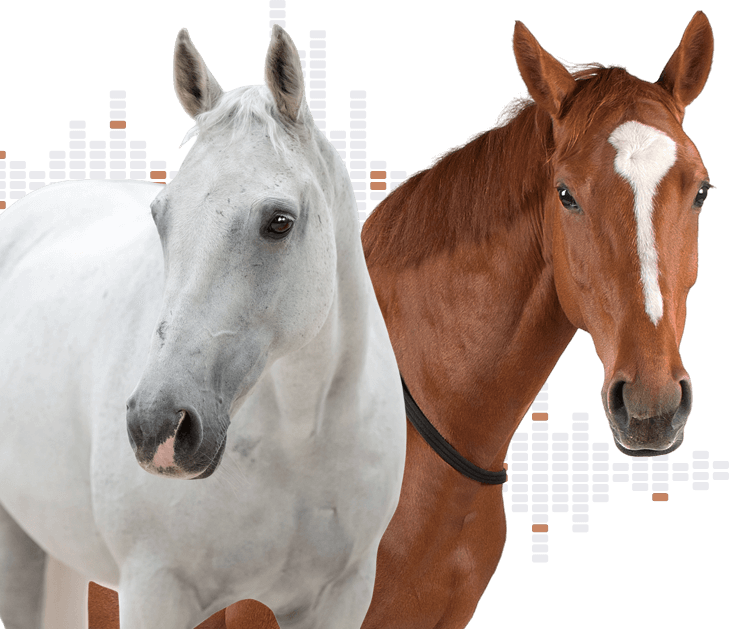Horses
Basics of Equine Colour Genetics
One of the first things everyone notices about a horse is its colour. Sometimes it’s pretty clear what colour a horse is, while at other times it sparks a full-on discussion — often about foals and young horses — regarding their actual colour. However, genetics can give you a straightforward answer. To some extent — while the main genetic mechanisms are known, some colour variants and their interactions still require clarification.
In horses, there are three base coat colours – black, chestnut and bay – which are determined by the interaction of two genes – Melanocortin 1 Receptor (MC1R), also known as the Red Factor or the Extension gene, and Agouti Signaling Protein (ASIP).
MC1R decides whether melanocytes, cells responsible for pigment production, produce black pigment, eumelanin, or red pigment, pheomelanin. Variants of this gene are typically marked with the letter E or e. A horse must have at least one dominant E allele for melanocytes to make black pigment. ASIP, usually marked with the letter A or a, regulates the distribution of said black pigment. If a horse carries at least one dominant A allele, the black pigment is reduced to legs, tail and mane. If not, the black pigment is evenly distributed over the whole body. ASIP doesn’t affect the colouring of chestnuts, as they do not produce black pigment.
|
Bay |
Black | Chestnut |
|
E/E, A/A E/E, A/a E/e, A/A E/e, A/a |
E/E, a/a
E/e, a/a |
e/e, A/A e/e, A/a e/e, a/a |
Some other factors must be at play, because there are clearly more than just these three coat colours in horses. These factors include other genes that can be divided into two groups: dilution genes and white pattern genes. These genes modify the base colour to create the final appearance — the phenotype.
Dilution genes influence either the amount of pigment produced or its transmission from melanocytes to hair follicles, making the horse lighter. An example of a dilution gene can be the cream gene, also known as MATP (membrane-associated transporter protein) or SLC45A2. This gene is inherited in an incomplete dominant pattern and it modifies the base colours into yellowish – cream undertone, resulting in palominos (chestnut base), buckskins (bay base) and smoky blacks (black base) when present in a single copy (CR/n). Horses with two copies (CR/CR) are cremellos (chestnut base), perlinos (bay base) or smoky creams (black base).
White pattern genes usually cause an absence of melanocytes in the unpigmented area — with the exception of grey horses, whose colouring is caused by an early shortage of melanocytes as they carry a mutation that speeds up their production in comparison to darker coloured horses.
Tobiano can be named as an example of a white pattern gene. Tobiano horses are characterized by large white spots over the topline on any base colour – chestnut, bay or black. This trait is inherited in a dominant pattern, meaning the horse has to inherit the allele (T/n or TO/n) only from one parent to be tobiano. A horse with two copies (T/T or TO/TO) is not only tobiano, but will also always pass on the tobiano allele to its foals.
The inheritance of horse coat colour is a complex topic that still requires further research to be fully understood. It’s important to keep in mind that the coat is not only affected by the genetic predisposition of the animal but also by external factors such as time of year, management and nutrition. For horse owners curious about the genetic background of their horse’s colour, whether for breeding decisions or simply understanding those unexpected coat colours, whole-genome sequencing may open the door to interesting genetic insights. Your horse could even help uncover the unexplained colourful secrets its genome holds.
make your order
Order online
our process
How does it work?
Take a few steps only to uncover your horse's DNA traits and learn more about his or her health and performance markers.


Select and Submit
Take charge of your genetic exploration journey by selecting the count of horses to be analyzed and any desired optional extras. Submit your order and expect a prompt response from our team.

Receive a Collection Package
We will deliver a package directly to your doorstep. It contains everything needed for a trouble-free blood sample collection by your veterinarian. After collecting the blood sample, simply send it back to us within 24 hours following the instructions you will also receive from us.

DNA Analysis Unveiled
We will isolate the genomic DNA of your horse from the sent blood sample. In our state-of-the-art laboratory, we will perform a whole genome DNA sequencing revealing the complex genetic information of your beloved horse.

Exclusive Data Delivery to Your Hands
We ensure the utmost privacy and exclusivity as we courier all the invaluable data and meticulously crafted reports directly to your hands. Of course, we remain at your disposal in case of questions!

EquineTest Online Storage
Once a year, if you wish, we will update your horse’s DNA sequencing report to reflect the current knowledge of horse’s markers of interest. Please notice there is a fast development in this field and considering the age and expected lifetime of your horse it may be worth to run this update service regularly. It will allow you to keep up with the latest scientific findings which are carefully monitored and implemented into our reports by our team of specialists.
what people say
Testimonials
get in touch
Contact us
![]()
We are located in the Czech Republic
Equinetest is a part of SEQme, a sequencing service provider since 2012.

SEQme s.r.o., Dlouha 176, 263 01 Dobris
(+420) 602 102 790 or (+420) 608 617 352 hello@equinetest.com

 Heidelberg, Germany
Heidelberg, Germany Budweis, Czech Republic
Budweis, Czech Republic Kuwait City, Kuwait
Kuwait City, Kuwait Göteborg, Sweden
Göteborg, Sweden